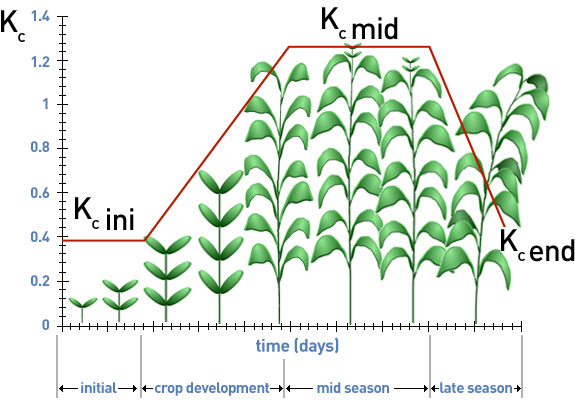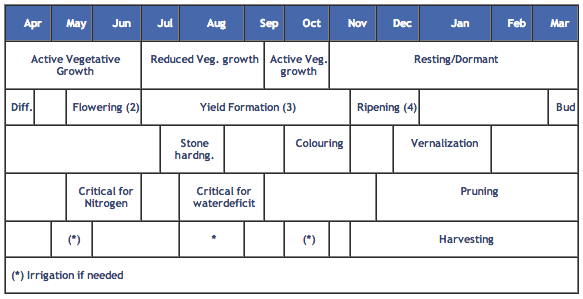Olive (Olea europacal) probably originated from the Eastern Mediterranean region of the Middle East. Present production is about 16 million tons green and black table olives and 2.7 million tons oil. Of the total production, 95 percent is produced in the Mediterranean region with Spain and Italy being the main producing countries FAOSTAT, 2001) .
The crop is indigenous to the Mediterranean region with a mild, rainy winter and a hot, dry summer. A dormancy period of about two months with average temperatures lower than 10° C is conducive to flower bud differentiation. Some cultivars are adapted to areas with higher winter temperatures but reduced flowering is noted under these conditions. During the dormancy period, the tree tolerates short periods of frost of -6° C, but during the bearing period frost causes damage to the fruits which are then only suitable for oil production. High temperatures and dry winds cause poor fruit setting and excessive drop of young fruits with remaining fruits shrivelling on the tree. A long, sunny, warm summer results in a high oil content of the fruit. High humidity at f lowering causes flower drop and infestation of sooty mould.
The crop produces acceptable yields on poor soil as long as it is deep, well-aerated and free from waterlogging. Under waterlogged conditions damage through lack of oxygen and fungal diseases increases sharply. The fertilizer requirements are 200 to 250 kg/ha N, 55 to 70 kg/ha P and 160 to 210 kg/ha K. Nitrogen is applied prior to or during the flowering and fruit formation period.
The olive tree is moderately tolerant to soil salinity provided ECe does not exceed 8 mmhos/cm, but ECe of 4.5 mhos/cm or less is preferred.
Raised for two years in the nursery, the tree is transplanted early in the season with 15 to 20 trees/ha under poor rainfed conditions and up to 300 trees/ha under irrigated conditions. Tree density is also dependent on the method of pruning. Early pruning is not essential but is often practised to obtain strong stems. However, for older trees, pruning during winter is necessary for high yields. Intercropping with grain forage and vegetable crops is sometimes practised in young orchards but is discontinued after 15 to 20 years under rainfed and after 6 years under irrigation.
More fruits are set than can be supported by sufficient nutrient supply, and this tendency increases as the trees get older. Consequently, a small number of flowers produce fruits. Early flower drop can be attributed to inadequate pollination, nutrient deficiencies or water shortage. Late flower and fruit drop is caused mainly by olive moth and olive fly attacks and water shortage. On the other hand, abundant fruiting adversely affects growth of annual shoots and the next year crop and eventually leads to alternate fruit bearing. This tendency is greater in older trees but alternate bearing is less pronounced with good soil and climate, and adequate management practices. The economic life of a tree is 50 years under rainfed conditions but under favourable growing conditions it can be much longer. A profitable harvest is obtained after 6 years but under more extreme conditions, after 15 to 20 years.
The graph below depicts the crop stages of olive, and the table summarises the main crop coefficients used for water management.

Stages of Development | Plant date | Region | |||||
|---|---|---|---|---|---|---|---|
Crop characteristic | Initial | Crop | Mid- season | Late | Total | ||
Stage length, days | 30 | 90 | 60 | 90 | 270 | – |
|
Depletion Coefficient, p | – | – | – | – | 0.65 |
| |
Root Depth, m | – | – | – | – | 1.7 |
| |
Crop Coefficient, Kc | 0.65 | >> | 0.70 | 0.70 | – |
| |
Yield Response | 0.2 | ||||||
Olive trees are commonly grown without irrigation in areas with an annual rainfall of 400 to 600 mm but are even found in areas with about 200 mm rainfall. For high yields, 600 to 800 mm are required. The crop coefficient (kc) relating maximum evapotranspiration (ETm) to reference evapotranspiration (ETo) is between 0.4 and 0.6.
he annual growth cycle of the olive tree in the subtropics with winter rain, together with the timing of cultivation practices, is shown in the figure below.

In the subtropics with winter rain, adequate soil water is generally available until the later part of the summer. For high yields, adequate water is required from the start of the stone hardening onward until the end of yield formation (3). During the yield formation period (3) adequate water supply increases fruit size and the flesh/pit ratio but the ripening period (4) is prolonged and the colouring of the fruit is delayed. Table olives, with a high flesh/pit ratio, require more water during the yield formation period (3) than olives produced for oil. In subtropical climates with little winter rain, water supply is also needed prior to flowering (2). Water deficits during the flowering period (2) may result in increased flower and fruit drop. Where needed, irrigation prior to the, start of flowering is recommended because irrigation during the flowering period (2) may lead to leaching of the essential supply of soil nitrogen.
Yields are strongly affected by twig growth during spring and early summer (from April to June in the northern hemisphere) and adequate water should be avail-able during this time. This applies also to the winter period because water deficits in winter cause reduced twig growth and defoliation. Further, this also causes a large percentage of imperfect flowers during spring while retarding flowering.
Adequate water supply during the active growth periods tends to reduce alternate bearing cycles. Water deficits in the spring adversely affect lead development and active growth, causing a reduction in yield during the same year and possibly also the next. When the crop is grown fully under irrigation, application of water could be discontinued only during the period between start of f lowering and the beginning of stone hardening.
Excess water results in short twigs, dense foliage with short and narrow leaves and reduced yields.
Under conditions of limited water supply, overall production is increased by extending the area and partially meeting crop water requirements, rather than by meeting full crop water requirements over a limited area.
After 3 to 4 years the tree forms a fascilar root system which continues to grow with age. In heavy textured and poorly aerated soils, roots are concentrated near the soil surface but are found at a greater depth in light textured soils. Lateral roots can be up to 12 m long. The tree thus explores a large volume of soil for nutrients and water. Generally, water uptake occurs over the first 1.2 to 1.7 m of soil depth (D = 1.2 to 1.7 m). Under conditions when maximum evapotranspiration (ETm) is 5 to 6 mm/day, the rate of soil water uptake by the crop starts to reduce when some 60 to 70 percent of the total available soil water has been depleted.
With winter rain of about 500 mm, irrigation is applied during and after stone hardening. Under conditions of little winter rain, irrigation is applied during bud differentiation (early spring), prior to flowering (early summer) and during yield formation and particularly during stone hardening. Irrigation is also applied at (a) two to three weeks before flowering; (b) when the fruit reaches one third its full size; and (c) when the fruit reaches almost full size.
For oil production, irrigation supply must be discontinued early enough to give a dry period during ripening. This will have little effect on the oil content but will reduce the water content of the fruit.
Irrigation is applied by different surface methods, but when limited water is available, localized irrigation is preferred.
The fruits of irrigated trees reach a high oil content later in the season than those of rainfed trees. Also, for irrigated trees the change of fruit colour from green to black is more gradual. Oil content as percentage of fresh fruit weight tends to be higher for rainfed than for irrigated trees but little difference is noted with oil content expressed as percentage of dry matter.
Time of picking depends on the use of the harvested product. Varieties with fruits of a high flesh/pit ratio and uniform shape are used for table olive production. In the northern hemisphere, green table olives are harvested from mid-September onward with end of harvest being determined when the fruit colour changes to green-yellow. Black table olives are harvested in December. Olives for oil are harvested from mid-December until March with oil content independent of the time of harvest.
Maximum oil content and weight are reached six to eight months after flowering. Olive fruits can be harvested long before they fall naturally.
Yields vary from year to year and from tree to tree. Good commercial yields under irrigation are 50 to 65 kg/tree of fruit with a possible maximum of 100 kg/tree of fruit. Oil content of the fresh fruit ranges from 20 to 25 percent. The water utilization efficiency for harvested yield (Ey) for fresh olives containing about 30 percent moisture is 1.5 to 2.0 kg/m3.
